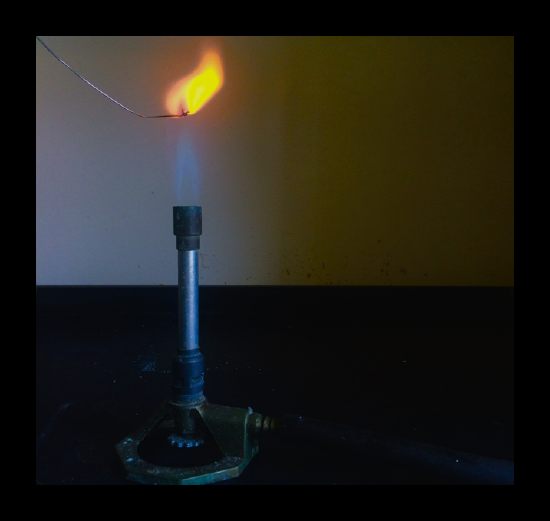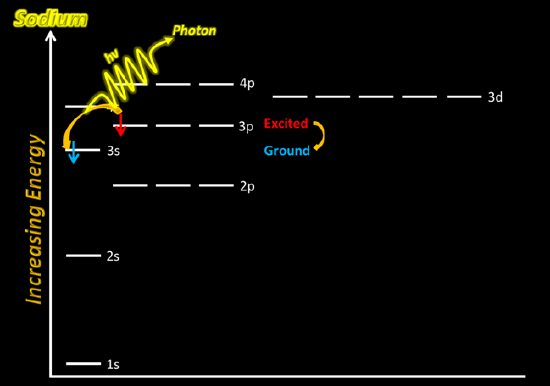What Happens to Electrons During a Flame Test
Flame Tests
- Page ID
- 3673
This page describes how to perform a flame examination for a range of metal ions, and briefly discusses how the flame color arises. Flame tests are used to identify the presence of a relatively modest number of metal ions in a compound. Not all metal ions give flame colors. For Group 1 compounds, flame tests are ordinarily by far the easiest way of identifying which metal you have got. For other metals, there are usually other easy methods that are more than reliable - but the flame examination can give a useful hint equally to where to look.
Practical Details in Carrying out Flame Tests
- Clean a platinum or nichrome (a nickel-chromium alloy) wire by dipping it into concentrated hydrochloric acid and and so holding it in a hot Bunsen flame. Echo this until the wire produces no color in the flame.
- When the wire is make clean, moisten it once more in the acid and and then dip it into a pocket-size amount of the solid to be tested then that some sticks to the wire. Place the wire back in the flame.
- If the flame color is weak, it is often helpful to dip the wire back in the acid and put it back into the flame as if cleaning it. This should produce a very brusk but intense wink of colour.
At that place volition, in fact, always be a trace of orange in the flame if you use nichrome. Platinum is much better to utilise but is much, much more expensive. If you accept a particularly dirty bit of nichrome wire, you tin can only chop the finish off. Yous do not do that with platinum! Dilute muriatic acid can be used instead of concentrated acrid for prophylactic reasons, simply does non always give such intense flame colors.
The colors in Table \(\PageIndex{1}\) are merely a guide. Almost everybody sees and describes colors differently. I take, for example, used the word "red" several times to describe colors that can exist quite different from each other. Other people employ words like "ruby" or "crimson" or "ruby", but non everyone knows the differences between these words - particularly if their beginning language is not English.
| Element | flame color |
|---|---|
| Lithium | scarlet |
| Sodium | strong, persistent orangish |
| Potassium | lilac (pink) |
| Rubidium | red (red-violet) |
| Cesium | blueish/violet (run across below) |
| Calcium | orange-reddish |
| Strontium | carmine |
| Barium | stake dark-green |
| Copper | blue-dark-green (often with white flashes) |
| Atomic number 82 | gray-white |
What practice yous do if y'all have a red flame color for an unknown compound and practise not know which of the various reds it is? Get samples of known lithium, strontium (etc) compounds and repeat the flame test, comparison the colors produced by 1 of the known compounds and the unknown compound side by side until you have a good match.
The Origin of Flame Colors
If y'all excite an atom or an ion past very potent heating, electrons can be promoted from their normal unexcited land into higher orbitals. As they fall back down to lower levels (either in i become or in several steps), energy is released as low-cal. Each of these jumps involves a specific amount of energy being released as lite energy, and each corresponds to a detail wavelength (or frequency). Equally a result of all these jumps, a spectrum of lines will be produced, some of which volition be in the visible part of the spectrum. The color you see will exist a combination of all these individual colors.
In the case of sodium (or other metal) ions , the jumps involve very high energies and these result in lines in the UV part of the spectrum which your eyes can't see. The jumps that you can see in flame tests come from electrons falling from a higher to a lower level in the metal atoms . And so if, for example, you put sodium chloride which contains sodium ions, into a flame, where do the atoms come from? In the hot flame, some of the sodium ions regain their electrons to course neutral sodium atoms again. A sodium atom in an unexcited state has the structure 1s22s22p63s1, merely within the flame there will exist all sorts of excited states of the electrons. Sodium's familiar bright orange-yellow flame color results from promoted electrons falling dorsum from the 3p1 level to their normal 3sane level.


The exact sizes of the possible jumps in energy terms vary from one metal to another. That means that each unlike metal volition accept a different pattern of spectral lines, and so a different flame color. Flame colors are produced from the move of the electrons in the metal ions nowadays in the compounds. For example, a sodium ion in an unexcited state has the electron configuration 1s22s22p6. When heated, the electrons proceeds energy and can be excited into whatever of the empty higher-energy orbitals—7s, 6p, 4d, or any other, depending on the amount of energy a particular electron happens to absorb from the flame. Because the electron is at present at a higher and more than energetically unstable level, it falls back downward to the original level, just not necessarily in one transition.
The electron transitions which produced lines in the visible spectrum involved atoms rather than ions.
Source: https://chem.libretexts.org/Bookshelves/Inorganic_Chemistry/Supplemental_Modules_and_Websites_(Inorganic_Chemistry)/Descriptive_Chemistry/Elements_Organized_by_Block/1_s-Block_Elements/Group__1%3A_The_Alkali_Metals/2Reactions_of_the_Group_1_Elements/Flame_Tests
0 Response to "What Happens to Electrons During a Flame Test"
Post a Comment